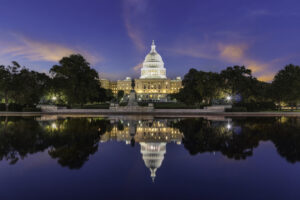The Scoop: Tropicana’s OJ carton PR disaster
Plus: Donald Trump chooses his press secretary; how CoverGirl woos micro influencers.

Quick, think of Tropicana orange juice.
You’re probably picturing a clear plastic carafe with a long, slender neck bearing an image of a straw-punctured orange.
But a new change has upended that clear branding position — and is costing the company big bucks.
CNN reports that Tropicana replaced its iconic carafe over the summer with a new container sporting a much shorter neck. That design is meant to reduce the plastic used in manufacturing and to make it easier for customers to pour. Notably, the bottle also holds just 46 ounces of orangey goodness, down from 52 ounces in the old bottle.
To compensate, the new bottle is intended to retail for 70 cents less than its predecessor — a good deal, given that you’re getting 11% less juice but paying about 15% less. However, some stores reportedly have not taken the manufacturer’s suggested retail price and are selling the new, shrunken bottles for the old price, leading to accusations of shrinkflation.
Customers also claim the new bottles are harder to pour and that they just don’t look as nice.
The fallout has been tangible. As of October, sales of Tropicana were down 19% year over year. It has yielded up to 4% of its market share to competitor Simply Orange.
Why it matters: Multiple hot-button topics are converging into one single snafu.
The topic of shrinkflation, or getting less product for the same cost, has dominated the conversation for years now, and customers are fed up. Major players like PepsiCo, which owns Lay’s and Doritos, have added volume back to their snacks to lure customers back. But in this case, Tropicana’s guidance on pricing has been ignored, leaving customers with less juice.
There’s also the emotional attachment people feel to the ubiquitous items they use every day. Tropicana differentiated itself with a bottle that conveyed freshness and familiarity, then took it away.
The CNN article notes that Tropicana has faced backlash before over packaging changes. In 2009, it changed its logo from that orange with a straw to a basic glass of orange juice.
Consumers were having none of it. Sales plummeted 20%. The logo was rolled back just six weeks later.
This time, it’s unlikely to back down so quickly — it’s far more expensive to change a bottle design than a label.
“Changes can take time, and after just a few months, we’re continuing to do what we can to help shoppers get accustomed to our new look,” a spokesperson told CNN, saying in-store elements and advertising were helping to tell their new story.
People are change averse, and sometimes they’ll quickly adjust. But a 19% sales decline is worrisome on every level. More storytelling and explanation on the front-end could have helped ease the transition, as well as research beforehand to understand the attachment to the old bottle.
We’ll see if customers give it a fair squeeze.
Editor’s Top Reads
- President-elect Donald Trump has chosen Karoline Leavitt to serve as his press secretary. At just 27, she’ll be the youngest person ever to command the briefing room podium. She previously served as Trump campaign press secretary. Before that, she made history as the youngest-ever candidate for Congress, though she lost the New Hampshire race. She endeared herself to Trump and MAGA world when she was kicked off CNN for impugning the impartiality of the network’s journalists. This likely sets the tone for Leavitt’s relationship with the press: fiery and antagonistic. During Trump’s first term, he had four press secretaries, many of whom went on to become household names, like Sean Spicer and Sarah Sanders, who now serves as governor of Arkansas. How will Leavitt’s star rise — or fall?
- Social network Bluesky is exploding in popularity as users, especially liberal ones, move away from X in the wake of the presidential election. In just a week, the platform’s user base doubled to 15 million, the New York Times reported. Bluesky Chief Jay Graber said the platform is setting itself up as David versus Goliath, making pledges not to use content to train AI (a notable departure from most other major social networks today) and to keep its open-source ethos. “The state of most social platforms right now is that users are locked in and developers are locked out,” Graber told the Times. “We want to build something that makes sure users have the freedom to move and developers have the freedom to build.” Those are noble aspirations for a platform in its infancy, but those pledges can come back to bite as companies grow and scale. People will remember what Bluesky says now — so best to tread lightly and not make promises they can’t keep. On the other hand, make sure you at least reserve your Bluesky company username, even if you aren’t ready to use it just yet.
- CoverGirl, which became famous as supermodels put the face in their walk, is now pivoting to make influencers the bread and butter of its marketing over glossy magazines and runway looks. One way they’re encouraging more influencers to feature their products in videos is by offering them access to their social media filming studio, glamorously located in the Empire State Building. One influencer given access to the space and profiled by the Wall Street Journal has just 17,000 followers. But wooing these micro influencers can make a big impact for a small price tag and earn a loyal following without needing to pay the likes of Tyra Banks or Christie Brinkley for similar promotions.
Allison Carter is editor-in-chief of PR Daily. Follow her on Twitter or LinkedIn.








I not only dislike the new bottle design, the taste seems to have changed also. I always bought the ‘Grovestand’ because it had extra pulp. it really tasted fresh squeezed. I’ll buy Florida’s Natural from now on.